Titan Transtage arrives at Johnson to be studied by orbital debris scientists
2016-05-30
The Titan Transtage, an upper stage of the Titan III rocket family, arrived at NASA’s Johnson Space Center May 26, where it will be studied by scientists in the Orbital Debris Program Office (ODPO) to obtain information to complete forensics that will help us understand why things break up in space.
Developed in the 1960s to lift heavy payloads, or multiple small payloads, to specific locations in low-Earth orbit (LEO) and Geosynchronous Earth Orbit (GEO), the Transtage was the world’s first “space tug” capable of multiple restarts of its engine and could deliver multiple spacecraft to precise orbits in a single mission.
As the global leader and expert on orbital debris, or “space junk,” the ODPO—a branch of JSC’s Astromaterials Research and Exploration Science Division—is interested in gleaning information to help interpret telescope measurements and data to incorporate into computer models of the space environment.
“Anything in space today could be involved in a collision, and objects still containing stored chemical or mechanical energy can explode,” said Dr. Phillip Anz-Meador, a project manager with NASA support contractor Jacobs. “Studying old—as well as new objects—is relevant to our understanding of the entire environment and its potential hazard to today’s robotic and crewed missions.”
The Transtage was at the U.S. Air Force’s 309th Aerospace Maintenance and Regeneration Group, better known as “the Boneyard,” at Davis-Monthan Air Force Base in Tucson, Arizona.
After scientists discovered a photo of the Transtage online, posted in a history forum taken by a runner in a 5K race at the Boneyard, they knew they’d found something special.
In the summer of 2015, Anz-Meador and Dr. Heather Cowardin, the University of Texas at El Paso’s optical lead scientist with NASA support contractor Jacobs, traveled to Tucson to visit the site. She determined that while the Transtage object was likely an engine test article rather than an unflown vehicle, it contained sufficient original components and details that it would make it valuable for scientists at JSC.
Anz-Meador notes that interest in the Earth’s orbital environment considers all objects launched to orbit, as well as the debris created in collision, explosions and environmental degradation, extending all the way back to the oldest remaining satellite, Vanguard 1, launched in 1958.
“While we will make a general survey of the vehicle to confirm sizes, shapes and masses, our main effort will be to characterize the spectral features of the materials used in the construction of this rocket body,” Anz-Meador said. “To accomplish this, we will use a handheld field spectrometer to collect spectral data.”
NASA orbital debris scientists are responsible for determining the total amount of orbital debris and predicting the risk to spacecraft, including the International Space Station. While Transtage flew several LEO and high-Earth orbit missions, its usual destination was GEO.
NASA used the Transtage to launch the agency’s Applications Technology Satellite 6, which pioneered GEO three-axis stabilization, deployable and steerable large antennas, electric thrusters, direct broadcast TV and educational TV programming in concert with the Indian Space Research Organization.
Orbital debris scientists conduct telescopic observations of the GEO region to characterize the debris environment down to a limiting magnitude or size, as several Transtages are known to have fragmented.
Anz-Meador said that some pieces from those events have officially been cataloged, but many remain that are not cataloged but still observable by telescopes.
“When a breakup occurs, fragments are created that span the size range from large components to very small, irregular debris,” Anz-Meador said. “Each of these has a spectral fingerprint that’s unique to the material, or materials, that it’s made from. We will collect spectra of the Transtage materials, and the data will be entered into a spectral database, a catalog of material fingerprints that uniquely identifies a given material and its application.”
The database will be used with existing spectral observations of GEO debris to look for matches. If orbital debris scientists find a match for a given object, it can then be recorded as most likely being an object of a particular material if cataloged, or maintained statistically for objects not cataloged.
“This means that a certain percentage of the un-cataloged population could be regarded as being metallic versus other materials such as plastics or insulation blankets,” Anz-Meador said. “In this way, we can better define the hazard posed to other space objects.”
The Transtage will be housed in Building 9S while it is being inspected and studied.
To learn more about NASA’s ODPO, visit: http://orbitaldebris.jsc.nasa.gov
Isidro Reyna
NASA Johnson Space Center
Developed in the 1960s to lift heavy payloads, or multiple small payloads, to specific locations in low-Earth orbit (LEO) and Geosynchronous Earth Orbit (GEO), the Transtage was the world’s first “space tug” capable of multiple restarts of its engine and could deliver multiple spacecraft to precise orbits in a single mission.
As the global leader and expert on orbital debris, or “space junk,” the ODPO—a branch of JSC’s Astromaterials Research and Exploration Science Division—is interested in gleaning information to help interpret telescope measurements and data to incorporate into computer models of the space environment.
“Anything in space today could be involved in a collision, and objects still containing stored chemical or mechanical energy can explode,” said Dr. Phillip Anz-Meador, a project manager with NASA support contractor Jacobs. “Studying old—as well as new objects—is relevant to our understanding of the entire environment and its potential hazard to today’s robotic and crewed missions.”
The Transtage was at the U.S. Air Force’s 309th Aerospace Maintenance and Regeneration Group, better known as “the Boneyard,” at Davis-Monthan Air Force Base in Tucson, Arizona.
After scientists discovered a photo of the Transtage online, posted in a history forum taken by a runner in a 5K race at the Boneyard, they knew they’d found something special.
In the summer of 2015, Anz-Meador and Dr. Heather Cowardin, the University of Texas at El Paso’s optical lead scientist with NASA support contractor Jacobs, traveled to Tucson to visit the site. She determined that while the Transtage object was likely an engine test article rather than an unflown vehicle, it contained sufficient original components and details that it would make it valuable for scientists at JSC.
Anz-Meador notes that interest in the Earth’s orbital environment considers all objects launched to orbit, as well as the debris created in collision, explosions and environmental degradation, extending all the way back to the oldest remaining satellite, Vanguard 1, launched in 1958.
“While we will make a general survey of the vehicle to confirm sizes, shapes and masses, our main effort will be to characterize the spectral features of the materials used in the construction of this rocket body,” Anz-Meador said. “To accomplish this, we will use a handheld field spectrometer to collect spectral data.”
NASA orbital debris scientists are responsible for determining the total amount of orbital debris and predicting the risk to spacecraft, including the International Space Station. While Transtage flew several LEO and high-Earth orbit missions, its usual destination was GEO.
NASA used the Transtage to launch the agency’s Applications Technology Satellite 6, which pioneered GEO three-axis stabilization, deployable and steerable large antennas, electric thrusters, direct broadcast TV and educational TV programming in concert with the Indian Space Research Organization.
Orbital debris scientists conduct telescopic observations of the GEO region to characterize the debris environment down to a limiting magnitude or size, as several Transtages are known to have fragmented.
Anz-Meador said that some pieces from those events have officially been cataloged, but many remain that are not cataloged but still observable by telescopes.
“When a breakup occurs, fragments are created that span the size range from large components to very small, irregular debris,” Anz-Meador said. “Each of these has a spectral fingerprint that’s unique to the material, or materials, that it’s made from. We will collect spectra of the Transtage materials, and the data will be entered into a spectral database, a catalog of material fingerprints that uniquely identifies a given material and its application.”
The database will be used with existing spectral observations of GEO debris to look for matches. If orbital debris scientists find a match for a given object, it can then be recorded as most likely being an object of a particular material if cataloged, or maintained statistically for objects not cataloged.
“This means that a certain percentage of the un-cataloged population could be regarded as being metallic versus other materials such as plastics or insulation blankets,” Anz-Meador said. “In this way, we can better define the hazard posed to other space objects.”
The Transtage will be housed in Building 9S while it is being inspected and studied.
To learn more about NASA’s ODPO, visit: http://orbitaldebris.jsc.nasa.gov
Isidro Reyna
NASA Johnson Space Center
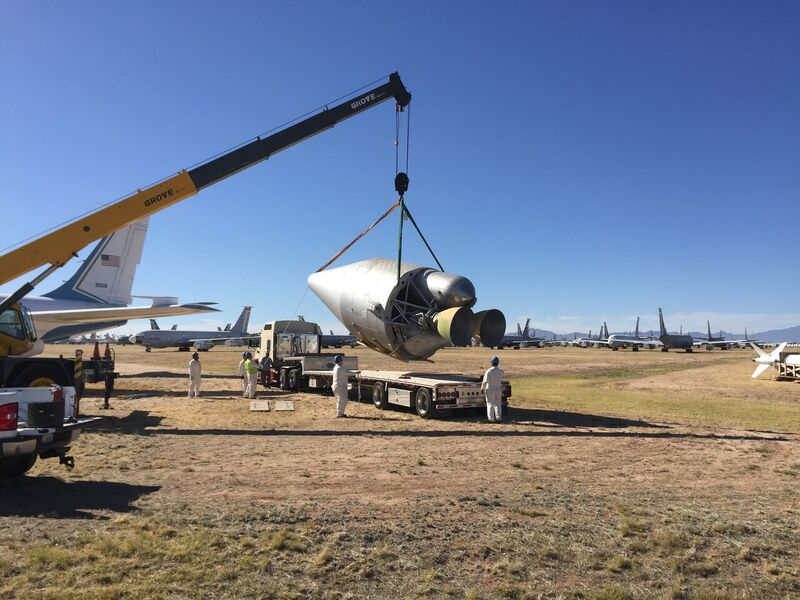
On May 24, the Titan Transtage is lifted onto a truck in Tucson, Arizona, at the U.S. Air Force’s Aerospace Maintenance and Regeneration Group, better known as “the Boneyard,” at Davis-Monthan Air Force Base in preparation for a cross-country trek to NASA’s Johnson Space Center. Image courtesy of Rob Raine, U.S. Air Force 309th Aerospace Maintenance and Regeneration Group.
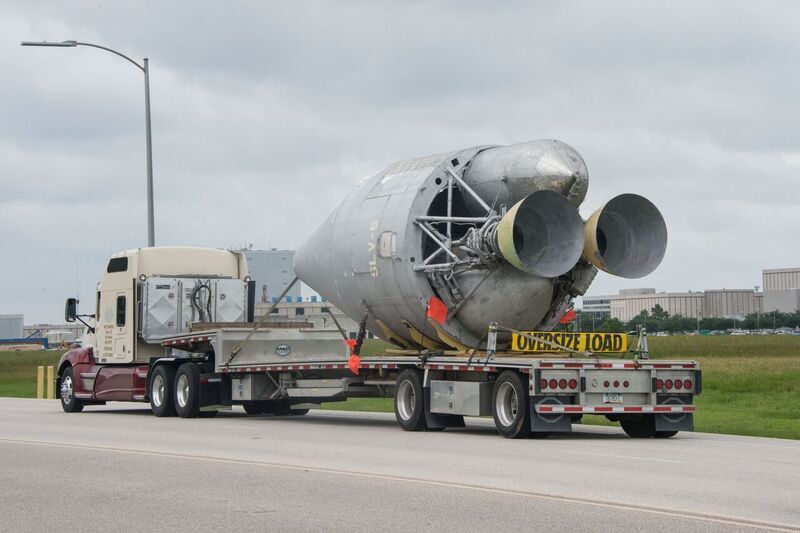
The Titan Transtage, an upper stage of the Titan III rocket family, arrives at JSC in Houston May 26, where scientists in the Orbital Debris Program Office will study it. Image Credit: NASA/David DeHoyos
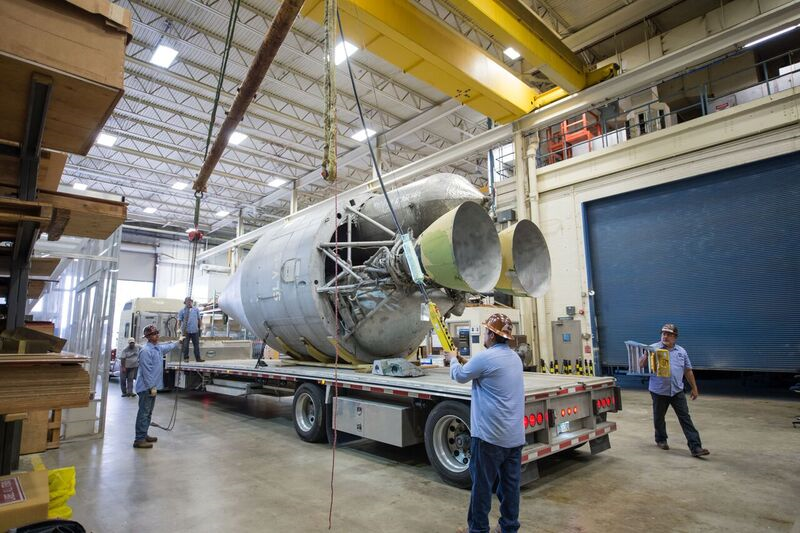
JSC employees prepare to unload the Titan Transtage in Building 9S. Image Credit: NASA/David DeHoyos
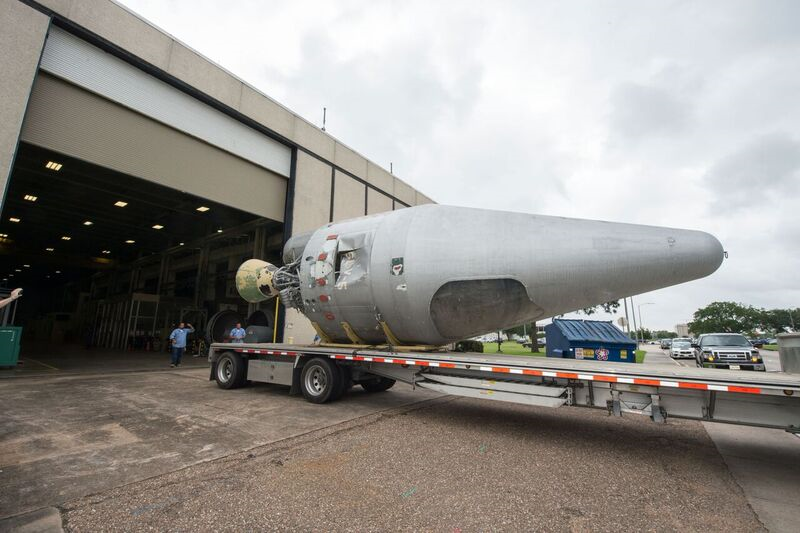
The Titan Transtage is hauled into Building 9S at JSC after completing a cross-country trek from Tucson, Arizona. Image Credit: NASA/David DeHoyos
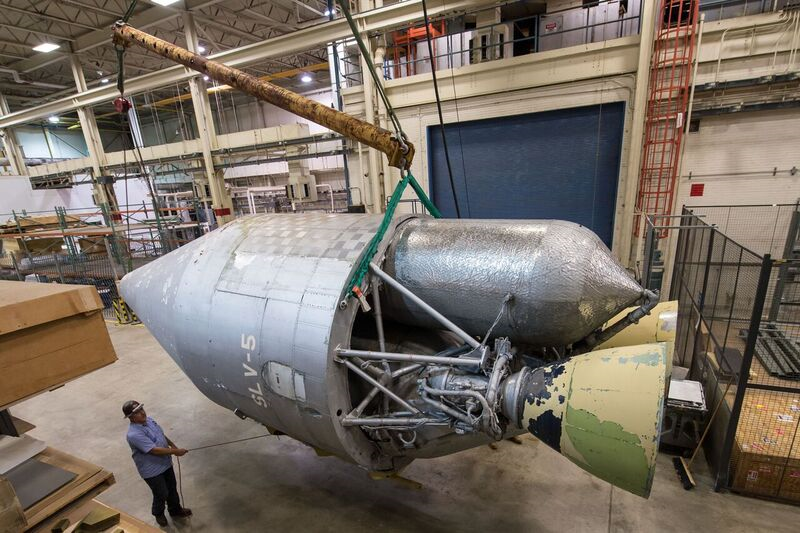
A JSC team member prepares the Titan Transtage for display in Building 9S, where orbital debris scientists will study the hardware to learn why things break up in space. Image Credit: NASA/David DeHoyos
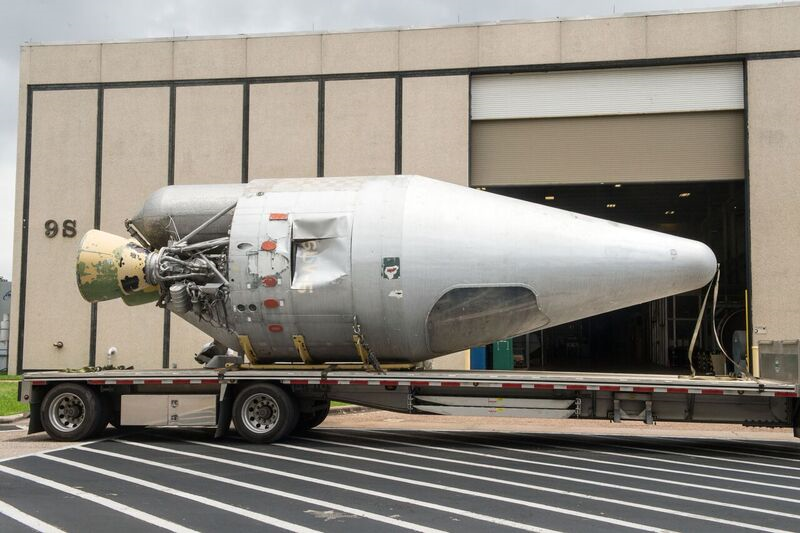
The Titan Transtage sits outside Building 9S. The hardware will be studied by JSC’s Astromaterials Research and Exploration Science Division to gather information to help interpret telescope measurements and data to incorporate into computer models of the space environment. Image Credit: NASA/David DeHoyos







